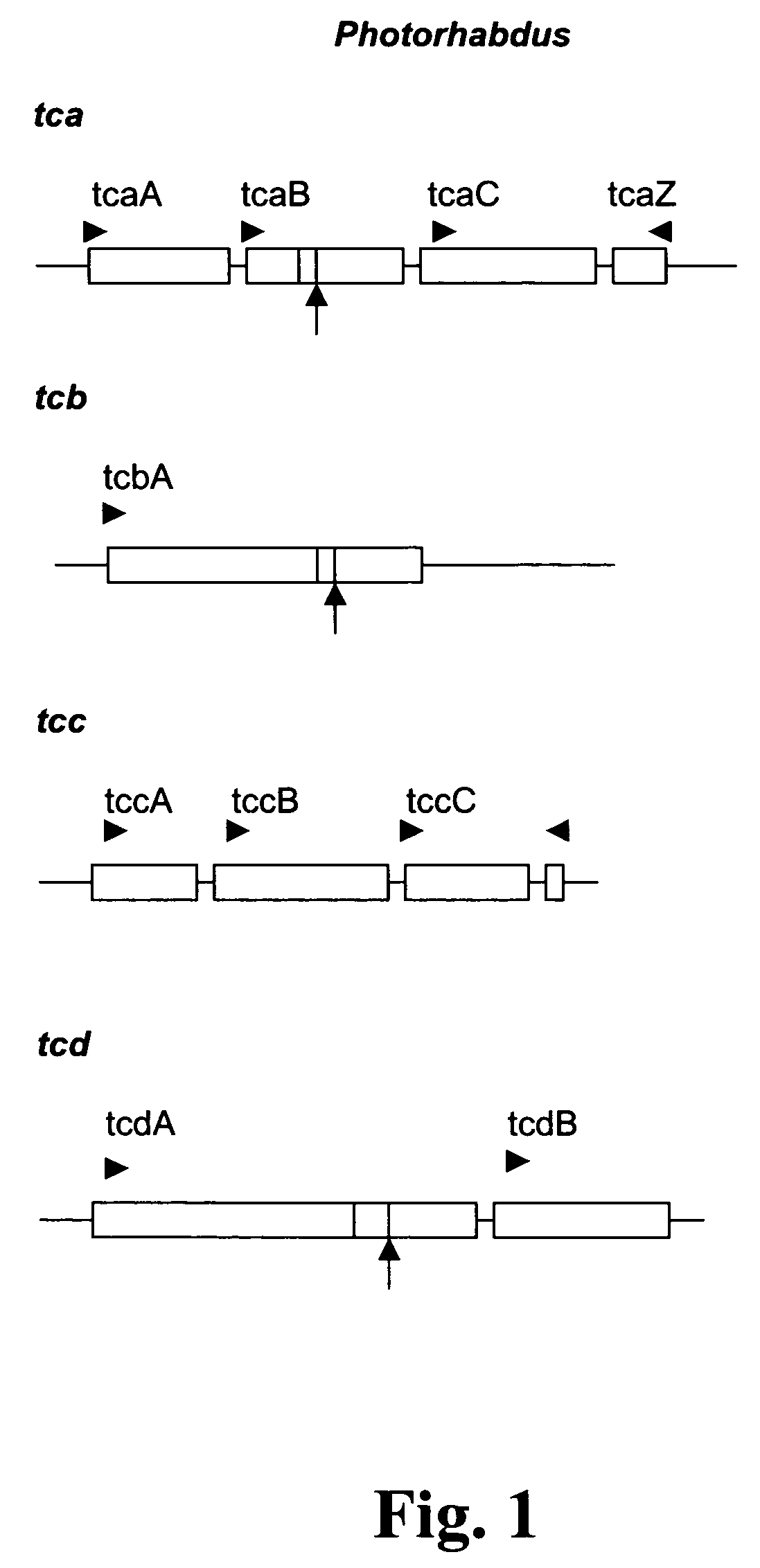Isolated toxin complex proteins from Xenorhabus bovienii
a technology of toxin complex and xenorhabdia bovis, which is applied in the field of isolate toxin complex proteins from xenorhabdia bovis, can solve the problems of reducing crop quality, crop loss, and the cost of keeping pests under control, and reducing crop yield
- Summary
- Abstract
- Description
- Claims
- Application Information
AI Technical Summary
Benefits of technology
Problems solved by technology
Method used
Image
Examples
example 1
Overview
[0150]The identification and isolation of genes encoding factors that potentiate or synergize the activity of the insect active proteins Photorhabdus TcdA and Xenorhabdus XptA2wi were accomplished using a cosmid complementation screen. Individual Escherichia coli clones from a cosmid genomic library of Xenorhabdus bovienii (strain ILM104) were used to create crude cell extracts which were mixed with purified toxins and bioassayed. Lysates were assayed with purified Photorhabdus toxin TcdA against southern corn rootworm larvae (Diabrotica undecimpunctata howardi). Likewise, lysates were also mixed with purified Xenorhabdus XptA2wi protein and assayed against tobacco budworm (Heliothis virescens) or corn earworm (Helicoverpa zea) larvae. Cosmid lysates were scored as positive if the combination of lysate plus purified toxin had activity greater than either component alone.
[0151]The primary screen samples (in 96-well format) were tested in duplicate and scored compared to contr...
example 2
[0153]Insect bioassays were conducted using artificial diets in either 96-well microtiter plates (Becton Dickinson and Company, Franklin Lakes, N.J.) or 128-well trays specifically designed for insect bioassays (C-D International, Pitman, N.J.). Eggs from 2 lepidopteran species were used for bioassays conducted in 96-well microtiter plates: the corn earworm, (Helicoverpa zea (Boddie)), and the tobacco budworm, (Heliothis virescens (F.)). Neonate larvae were used for bioassays conducted in 128-well trays. The lepidopteran species tested in this format included the corn earworm, the tobacco budworm, and the beet armyworm, (Spodoptera exigua (Hübner)). A single coleopteran species, the southern corn rootworm, (Diabrotica undecimpunctata howardii (Barber)), was also tested in this bioassay format.
[0154]The data recorded in these bioassays included the total number of insects in the treatment, number of dead insects, the number of insects whose growth was stunt...
example 3
[0156]Xenorhabdus strain ILM104, previously determined to represent the species X. bovienii by 16S RNA sequence determination (Midi Labs, Newark, Del.), was grown on 2% proteose peptone #3 (hereafter designated as PP3) agar containing 0.0025% brom thymol blue for 72 hours at 28° C. A single, brom thymol blue-adsorbing colony was selected and used to inoculate 500-mL tri-baffled flasks containing 175 mL of PP3. Shake flasks were shaken at 150 rpm and incubated at 28° C. for approximately 24 hrs. Fifty mL of this culture was centrifuged at 2,400×g to pellet the cells. The supernatant fluid was removed and the cell pellet was frozen at −20° C. until it was thawed for total cellular DNA isolation.
[0157]Total cellular DNA was isolated using a Genomic DNA purification kit (Qiagen Inc., Valencia, Calif.). The frozen bacterial cell pellet was resuspended by vortexing in 11 mL of Buffer B1 (50 mM Tris / HCl, pH 8.0; 50 mM EDTA, pH 8.0; 0.5% Tween 20, 0.5% Triton X-10...
PUM
 Login to View More
Login to View More Abstract
Description
Claims
Application Information
 Login to View More
Login to View More - R&D
- Intellectual Property
- Life Sciences
- Materials
- Tech Scout
- Unparalleled Data Quality
- Higher Quality Content
- 60% Fewer Hallucinations
Browse by: Latest US Patents, China's latest patents, Technical Efficacy Thesaurus, Application Domain, Technology Topic, Popular Technical Reports.
© 2025 PatSnap. All rights reserved.Legal|Privacy policy|Modern Slavery Act Transparency Statement|Sitemap|About US| Contact US: help@patsnap.com

